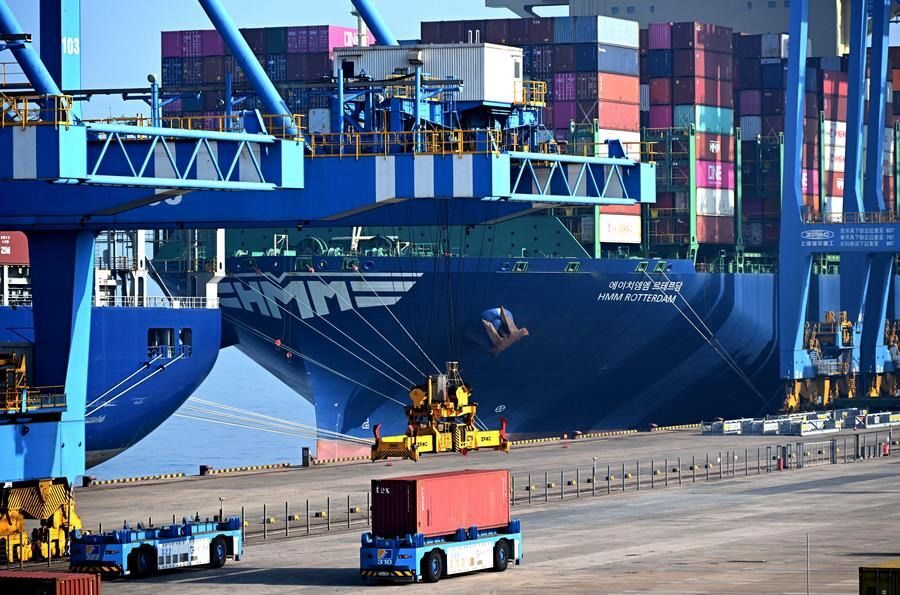BEIJING(WNAM Report): Every week, around 30 freight trains from China arrive in Duisburg, a city lying in Germany’s Ruhr region and a major hub for China-Europe Railway Express (CRE). As existing facilities have reached capacity limits, a new terminal will be operational this summer to handle the freight from and to China.
During the COVID-19 pandemic, Duisburg and other European cities with CRE service witnessed a surge in freight rail traffic with China. The recent Red Sea crisis also led to an increasing demand for the service.
CRE is a key project of the Belt and Road Initiative (BRI). Since its inception a decade ago, the initiative has grown into a widely acclaimed global public good and platform for cooperation, opening up new space for the world’s economic growth.
Despite the BRI’s popularity, a rhetoric has emerged recently in some Western countries, which claims that China’s comparative strength is peaking. One of the arguments the “Peak China” theorists claim is that China is facing a worsening external environment, rising geopolitical risks, a wave of foreign capital withdrawal, and a shift in global supply chains. Data shows that China received 1.1 trillion yuan (around 150 billion U.S. dollars) in actual foreign investment in 2023. Despite a dip of 8 percent year on year, the figure only lost to the levels seen in 2021 and 2022.
This is something that deserves applauding given the grim picture in the whole world. The UN Conference on Trade and Development (UNCTAD) revealed in a report in January that when a few European “conduit economies,” intermediaries for foreign direct investment (FDI) destined for other countries, are excluded, global FDI flows show a decline as steep as 18 percent. China’s FDI fluctuated for several reasons. The country is still reeling from the COVID-19 pandemic, and disruptions to visits and exchanges affected the investment decisions of multinational companies. Moreover, the shrinking global cross-border investment has intensified worldwide competition for inbound investment and resulted in certain capital diversions away from China.
Generally speaking, the structure of foreign investment in China is optimizing. In 2023, China received 423.34 billion yuan of investment in high-tech industries, about 37.3 percent of paid-in foreign investment, an increase of 1.2 percentage points compared to 2022. Also, the fluctuations have not changed the fundamentals sustaining the sound economic growth in China. The country’s enormous market and its complete industrial chains and supply chains are expected to be a lasting magnet for foreign investors.
More multinational corporations are expanding their presence in China. In September 2023, Airbus kicked off construction on its second final assembly line in north China’s Tianjin Municipality. German chemical giant BASF is investing up to 10 billion euros to build an integrated Verbund site in Zhanjiang, south China’s Guangdong Province. The first thermoplastic polyurethane production lines at the new Verbund went into operation recently.
The uncertainty of China’s external environment is indeed rising, as a result of the containment and suppression by some Western countries.
The past few years have witnessed a carousel of tactics targeting China, ranging from “decoupling” to “de-risking,” “small yard, high fence,” and most recently “friend-shoring.”
On the pretext of national security, these countries have employed state power to stifle Chinese companies in an attempt to establish a “technological sphere of influence” and prevent China from getting advanced technology and equipment.
China’s position as the “world’s factory,” however, remains unshakable. According to China Customs, the country’s total trade in goods reached 41.76 trillion yuan in 2023, up 0.2 percent, in which exports totaled 23.77 trillion yuan, up 0.6 percent.
In comparison, a UNCTAD report in December predicted that global trade would drop by about 1.5 trillion U.S. dollars to below 31 trillion dollars in 2023, a 5 percent decline compared to the level in 2022.
Chinese companies are still expanding their overseas footprints. In 2023, China became the world’s top automobile exporter for the first time, selling 4.91 million vehicles overseas, a year-on-year increase of 57.9 percent.
In Europe, following a battery factory launch in Germany in early 2023, China’s electric vehicle battery maker Contemporary Amperex Technology is spending 7.34 billion euros to build a factory in Hungary, with production expected to begin in 2025.
China never shies away from the difficulties and challenges it faces. In December, an annual Central Economic Work Conference called for attention to “the complexity, severity and uncertainty” of the country’s external environment.
China’s solution to it is high-level opening up with concrete policies. It announced that all restrictions on foreign investment access in its manufacturing sector would be lifted, and has introduced unilateral visa-free policies to countries including Germany and France.
China advocates an inclusive economic globalization that benefits all, opposes unilateralism and protectionism, and resists discriminatory and exclusive standards and rules. This has won support from most countries, especially those in the Global South.
China’s economic relations with ASEAN, Regional Comprehensive Economic Partnership countries, and Africa have become ever more active in recent years. Its trade volume with BRI partner countries reached 19.47 trillion yuan, accounting for 46.6 percent of its total trade value and outpacing its overall foreign trade growth.
In 2023, over 150 countries attended the third Belt and Road Forum for International Cooperation held in Beijing, achieving 458 outcomes and agreements worth 97.2 billion dollars.
China is proactive in navigating a complex international environment, engaging in head-of-state diplomacy, developing a community with a shared future for humanity, bringing BRI cooperation to a new stage of high-quality development, and helping the BRICS deliver a historic expansion in its membership last year.
While promoting global peace, stability and prosperity, these measures also foster a favorable external environment for China’s own growth.


